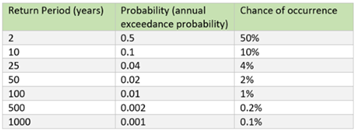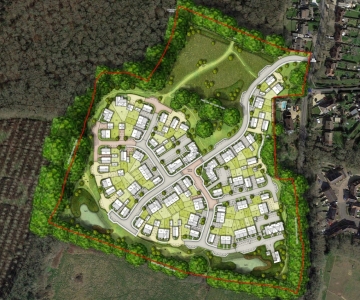Innovators In The Land Promotion And Housebuilding Sector
As innovators within the land promotion sector, Catesby Estates was one of the first to recognise the importance and added value, in-house technical expertise can deliver to both landowners and housebuilders.
Our technical team is unique amongst land promoters, and are able to bring forward sites with comprehensive technical background work completed, and offer value engineered solutions to any site constraints.
This means there is less upfront risk for a housebuilder, that comes with a land site that has not been fully considered from a technical and deliverability perspective.
This in turn increases the speed of housing delivery, with housebuilders able get onsite and start construction quicker.
In this article our technical team explain flood risk and how it can be managed effectively when delivering new homes.
What Is Flood Risk?
Flood risk is a combination of the probability of an event happening and the consequences if it occurred.
Flood risk is dependent on there being a source of flooding, such as a river, a route for the flood water to take and something that is affected by the flood such as a housing estate or a road.
The consequences of a flood depend on exposure and vulnerability. Exposure is a measure of the number of people or things that may be affected by a flooding event while vulnerability is a measure of the potential of people or things that could be harmed.
The likelihood of a flooding event happening is summarised in the below table.

Return periods are often used to describe how often a flooding event will occur but using terms such as 1 in 50 years can mislead the public into thinking that a 1 in 50-year flood event will only occur every 50 years.
Return periods are an average of how often a flood event of that extent will occur, and so the probability or chance of flooding should be used instead. For example, a 1 in 50-year flood has a 2 per cent probability of occurring in any one year.
Flood Risk Management
Flood Risk Management for development sites can be achieved by various techniques.
The various methods of how flooding and rainfall can be managed within a development are:
- Utilising Attenuation basins, Storage tanks, Swales, Oversized Storage Pipes and Culverts, sized to cater for the various storm events plus an allowance for climate change and urban creep. Our Engineers use the latest modelling software, which takes into account the sites impermeable area and also the discharge outfall rate which has been agreed with the Lead Local Flood Authority (Council department) which manage local flood risk and/or the Internal Drainage Board (Public bodies that manage water levels) to ensure adequate attenuation is provided on site which ultimately feeds into the new sites masterplan.
- Use of Permeable Paving not only reduces the flow of rainwater run-off from the site, but also provides a treatment train for the water as it passes through the different layers of stone beneath the paving. This technique can also be used on sites that sit on impermeable land, via a tanked system with a pipe beneath the sub-base which connects into a surface water drainage system. This technique is regularly used on private parking pays for example.
- Drainage maintenance schemes are put in place post construction to ensure Silt Chambers, Headwalls, Trash Screens and Road Gullies are regularly cleared out & emptied to avoid unnecessary and avoidable localised flooding.
- Rainwater Harvesting can be proposed. This method collects rainwater into a storage tank/ reservoir which can then be used for many household needs such as for flushing toilets, garden taps and car washing. Not only does this reduce rainwater from going into a surface water sewer or watercourse but also saves on water bills.
- Flood Routing Plan. Should the new drainage system ever fail, the run-off will flow overland to the nearest watercourse, ditch or open space area, not affecting any of the localised residential properties or primary access points for vehicles and pedestrians.

We produce a Flood Risk Assessment which considers all aspects of flood risk together with a supporting surface water drainage strategy when submitting a Planning Application for residential development.
Housebuilders and Local Authorities can be confident a planning permission obtained by Catesby Estates is deliverable.





